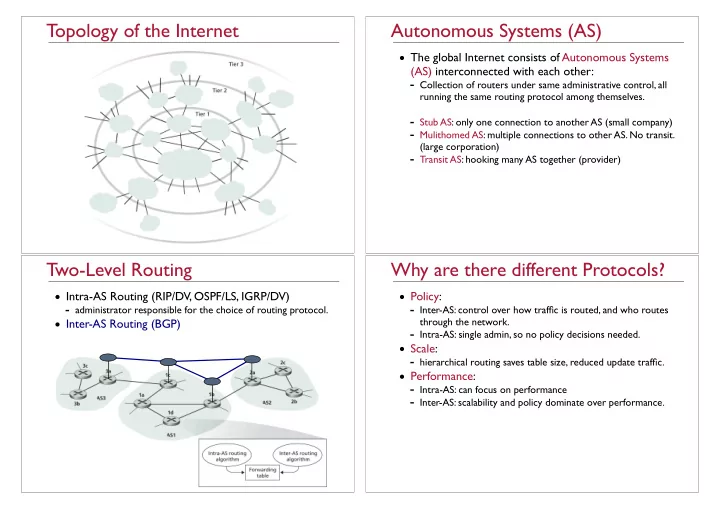

Topology of the Internet Autonomous Systems (AS) • The global Internet consists of Autonomous Systems (AS) interconnected with each other: - Collection of routers under same administrative control, all running the same routing protocol among themselves. - Stub AS: only one connection to another AS (small company) - Mulithomed AS: multiple connections to other AS. No transit. (large corporation) - Transit AS: hooking many AS together (provider) Two-Level Routing Why are there different Protocols? • Intra-AS Routing (RIP/DV, OSPF/LS, IGRP/DV) • Policy: - administrator responsible for the choice of routing protocol. - Inter-AS: control over how traffic is routed, and who routes • Inter-AS Routing (BGP) through the network. - Intra-AS: single admin, so no policy decisions needed. • Scale: - hierarchical routing saves table size, reduced update traffic. • Performance: - Intra-AS: can focus on performance - Inter-AS: scalability and policy dominate over performance.
IPv4 Addressing • An IP address is an identifier for a host/router interface. - Interface: connection between host/router and physical link - Routers have several interfaces, hosts can have several interfaces. IPv4 Address Structure Interface Addresses and Subnets • IPv4 Addresses: 32 bit A Router (layer 3) • Human readable form: a.b.c.d (where a,b,c,d are 8bit values) connects layer 2 networks. example: 130.238.8.176 These networks are also called Subnet and have network/prefix host their own network id. x bits 32-x bits • Routing is only based on the network identifier. - prefix = x MSB of the address (x: mask) - we use the following notation for the prefix: a.b.c.d/x - in Windows the mask has the form of e.g., 255.255.255.0 (=/24)
Routing Table Example Forwarding Policy • check if destination address matches the prefix of the Routing Table at router R2 (simplified) subnet next hop L2 if incoming network interface: 223.1.1.0/24 223.1.9.2 3 - if it does: pass packet to transport layer (node is destination) 233.1.2.0/24 -* 1 - else drop packet (the destination is on same network, no 223.1.3.0/24 223.1.8.0 2 forwarding required) 223.1.7.0/24 223.1.8.0 2 • else, choose longest matching prefix in routing table. 223.1.8.0/24 -* 2 223.1.9.0/24 -* 3 • forward packet based on next hop information. prefix 3 2 1 * this subnet is directly connected to the router. Default Router Address Resolution Protocol (ARP) • Entry in the routing table of a host or router, • Translation between network-layer addresses and link- specifying to which router a message that does not layer addresses. match any prefix should be forwarded to. 130.238.8.100 > 49-BD-D2-C7-56-2A • Resolution on same local link only (not-end-to end): • Usually a gateway to other networks, e.g., the Internet. “who has 130.238.8.100, tell 130.238.8.123” “reply 130.238.8.100 is at 49-BD-D2-C7-56-2A” • Resolution at every router! • Cache to avoid ARP request for every single packet (expires after ca. 20 minutes)
Configuration on a Host Hierarchy - a Key to Scalability • Hierarchical Naming - domain names: uu.se, it.uu.se network/prefix host - fully qualified domain names: rama.it.uu.se, www.google.com size: x bits - Domain Name System • Hierarchical Addressing • Address: network/prefix, host > identifyer - use of prefixes: 220.23.16.0/20, 200.23.16.0/23 • Network mask > recognise prefix (network) - IPv4 Addresses • Default router > router for traffic not on same netw. • DNS server • Hierarchical Routing - tightly related to addressing - Autonomous Systems (intra-AS and inter-AS routing) Hierarchical Addresses Network Address Allocation Example without guarantee sunet.se 130.242.88.17/11 242: 11110010 uu.se 130.238.0.0/16 238: 11101110 it.uu.se 130.238.8.0/24 student.uu.se 130.238.5.0/24
Network Address Allocation More Addresses... • Allocation of prefixes is necessary for routing efficiency but inefficient in terms of address usage. • IPv6 - Extended addressing capabilities (net|id, id unique) - Streamlined header (40 Bytes) - Flow labelling and priority • Network Address Translation (NAT) - IP addresses have only a local scope 10.0.0.0/8 , 192.168.0.0/16 (“non routable” addresses) - Typical home/student network. • Note: It is not the goal to improve address usage efficiency. How does an IPS get a block of addresses? ICANN: Internet Corporation for Assigned Names and Numbers Alternative Routing Approaches • Label Switching - Hop-by-hop addresses (labels) - Example: Multiprotocol Label Switching (MPLS) • Probabilistic Routing - The routing table indicates the probability to deliver to the destination based on prior experience. - Forward a message if higher probability than previous hop. - Example: Prophet routing protocol (Sami Network Connectivity) • Content Routing - Finding information rather than a specific address.
Recommend
More recommend